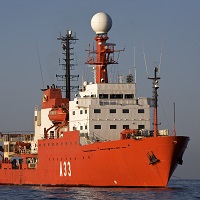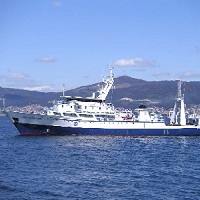Keyword
110
17 record(s)
Type of resources
Categories
Topics
INSPIRE themes
Keywords
Contact for the resource
Provided by
Years
Formats
Status
-

The overall objective of the cruise was to perform a systematic geophysical survey. Particularly its main aim is to get a complete sea-floor coverage.The investigation is the result of a co-operation between the Royal Observatory (ROA) and the Hidrographic Institute (IHM) (both from the Spanish Navy) under the control of the General Technical Secretary of the Spanish Dpt of Defense. (SEGENTE), with the collaboration of several other Spanish institutions and universities.The cruise started on Sept. 19th at Cadiz. Gordon's Tropical storm as well as some tecnical problems related with the multi-beam echo sounder (Simrad EM-120) conditioned its kicked-off. This technical failure limited us to work at shallow waters, changing so our initial planning. Finally we ended at Coru?a on October 9th.
-
IHM 0172
-
Timing and frequency of landslide and gravity flow geohazards along the eastern North Atlantic continental margin This research cruise was a contribution towards the NERC strategic science programme (Oceans 2025). The main scientific objective was to improve our understanding of landslide and gravity flow geohazards along the eastern North Atlantic margin, in particular by studying event timing and frequency in the recent geological record. Special attention was being paid to geohazards that may potentially impact UK communities and infrastructure. Shallow piston coring of turbidite successions in deep basins produces the best record of recent (<50 kyrs) gravity flow events on adjacent margins (e.g. Weaver et al., 2000), but the availability of pre-existing data from the study area was patchy. Consequently, a key aim of JC027 was to 'fill the gaps' and recover cores from basins, or sections of basins, where data are urgently required. A total of 60 piston and megacores was successfully recovered during the cruise, from a series of lower canyon and basin floor environments. Shallow geophysical data, including subbottom profiles and hull-mounted multibeam bathymetry, were collected quasi-continuously during the cruise to define local environment around core sites. In complex areas, such as seafloor scours, Autosub6000 was deployed to collect high-resolution EM2000 multibeam bathymetry.
-
CTD stations on 20W line from 50N to 20N, following the old WOCE line A16N Physical measurements (CTDO and LADCP) and discrete samples for salt, oxygen, inorganic nutrients and alkalinity/inorganic carbon Underway ADCP, surface ocean measurements, surface meteorology measurements. Contribution to GO-SHIP sustained hydrography program. Partial repeat of a hydrographic line last occupied in 2003.
-
Objectives: To quantify marine halocarbon emission variability and latitudinal variation, characterise in situ open ocean atmospheric reactive iodine latitudinal variability and characterise oxidative chemistry perturbation due to oceanic emission of halogens from the Mauritanian upwelling region. Rationale: Transecting from the UK through Biscay, south past the west coast of Africa, through the Mauritanian upwelling, to pass Cape Verde simultaneous to the intensive deployment at the UK SOLAS Observatory on Sao Vicente, the measurements made on Discovery cruise D319 are intended to provide a detailed latitudinal characterisation of marine atmospheric halogen chemistry. This will feed validation and constraint data to regional and global models in projects linked to RHaMBLe. In addition the cruise will address a number of key scientific questions required to determine the global importance of iodine chemistry and to further our understanding of the controls of halogen chemistry in the remote ocean: i) How heterogeneous are the direct halogen sources and on what scale is the heterogeneity - does the upwelling region produce more or less halogens than the 'background' region? ii) What are the relative contributions of I atoms to the remote MBL from I2 and organic iodine? iii) Is sufficient iodine released to the remote MBL to sustain aerosol nucleation or to significantly affect the ozone budget and free radical populations? Measurement Description: Measured species included a variety of halocarbons in both water column and atmosphere and atmospheric boundary layer measurements of I2, OIO and IO by Broadband Cavity Enhanced Absorption Spectroscopy (BBCEAS). A compact version of the FAGE system, developed for the FAAM BAe-146, was deployed to provide measurements of IO or OH / HO2, permitting direct assessment of RHS-induced changes in the oxidising environment through the upwelling region. A range of trace gas monitors was simultaneously deployed to measure O3 and NOx. Aerosol number and size distribution measurements from 3 nm to 20 micron diameter were also made by a range of mobility (SMPS) and optical instrumentation, (OPC and FSSP). Additional aerosol measurements were provided as part of the NERC-funded ACMME project (PI Allan). Measurements of pigments in the surface waters were made by HPLC. Prevailing meteorological conditions were used to direct the cruise in terms of geographical positioning and measurement interpretation, e.g. i) exploitation of any broad flow connection between Cape Verde and the ship to interpret measurements as process studies and ii) identification of in- and out-of-plume conditions to contrast chemistry influenced and uninfluenced by emissions from the upwelling region.
-
To estimate nitrogen (NH4+, NO2-, NO3-), phosphate and silicate fluxes in the Strait of Gibraltar, to quantify and characterise the fluxes of particulate organic carbon and nitrogen (POC/PON) and to estimate of picoplankton, nanoplankton and microplankton biomass distribution in the Strait of Gibraltar To describe the hydrological structure and the geochemical fields of the region of the Gulf of Cadiz, particularly at the levels influenced by the Mediterranean waters, in order to set a background for interpreting the dynamics of the Outflow
-

Norcanarias - 1
-

CR CANIGO 0198 A serie of hydrology sections were made across the main stream of the Mediterranean Outflow, in the Gulf of Cadiz and off the SW of the Iberian Peninsula. Water samples were taken at selected stations for the quantification of chemical parameters (Nutrients, Oxygen and Particulate Matter)/C2945615.998
-

CINECA I (February-1973)
-
The objectives of the BELMER project are: - to validate the MERIS water products for Belgian coastal waters and neighbouring French, UK and Dutch waters - to provide a quantitative statement of product accuracy and recommendations for improvements in the scientific algorithms, where appropriate. In particular the problems reported by the MERIS validation and user communities of turbid water atmospheric correction, case 2 water chlorophyll retrieval, adjacency effects (straylight), moderate sunglint, spatio-temporal variability of specific inherent optical properties and bottom reflectance will be addressed. This project is funded by the "PROgramme for the Development of scientific Experiments" (PRODEX) of the European Space Agency (ESA).
 Catálogo de datos del IEO
Catálogo de datos del IEO